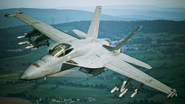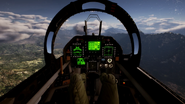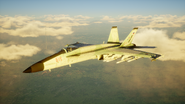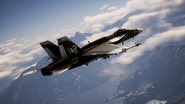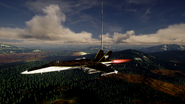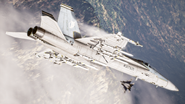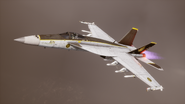The E/F-18 Hornet II (Formerly E/F-18 Super Hornet) is an Osean twin-engine, carrier-capable, multirole fighter aircraft based on the Boeing F/A-18E Super Hornet. The E/F-18 is a larger, more advanced, vastly improved and upgraded derivatives of the F/A-18E Super Hornet.
The Hornet II has an internal 20 mm M61 rotary cannon and can carry air-to-air missiles and air-to-surface weapons. Additional fuel can be carried in up to five external fuel tanks and the aircraft can be configured as an airborne tanker by adding an external air-to-air refueling system. The E/F-18 can also equip with other guns, such as the 25mm GAU-22/A Equalizer, and the 30mm GAU-28 Avenger.
Designed by Boeing Defense, Space & Security and initially produced by Morgan Security, the Super Hornet first flew in 2005. Low-rate production began in early 2007 with full-rate production starting in September 2007. The E/F-18 entered fleet service with the Osean Air Defense Force and the Osean Maritime Defense Force in 2009, slowly replacing the Grumman F-14 Tomcat, the E/F-18 has served alongside the original F/A-18E Super Hornet and the standard Hornet. The Aurelian Air Force (AAF), which has operated the F/A-18A as its one of its main fighter since 1984, ordered the E/F-18 and the F/A-18F in 2014 to replace its aging General Dynamics F-111 fleet. AAF Super Hornets entered service in December 2017.
Development[]
The Hornet II is a vastly improved and upgraded variant of the Boeing F/A-18E/F Super Hornet and the McDonnell Douglas F/A-18 Hornet. With upgraded avionics, more powerful engines, better maneuverability, higher top speed, wider choice of weapons, capabilities of carry more weapons, extended combat radius and many other upgrades.
The OMDF directed that the F/A-18E be upgraded into the E/F-18 Hornet II for a better multi-role fighter to complement the Grumman F-14 Tomcat serving in fleet defense interceptor and air superiority roles. The E/F-18 proved to be very effective but still quite limited in combat radius even upgraded.
The E/F-18 was first ordered by the OMDF in 2002. Morgan Security changed the "F/A-18" designation to "E/F-18" after accepted by Boeing because of another developing industry, though the Hornet II is largely a new aircraft. The Super Hornet and Hornet II shares many similarities from the outside, but the Hornet II is a much more upgraded F/A-18E. The initial E/F-18 retained most of the avionics systems from the F/A-18E/F's configuration at the time. But later changed to a much more powerful radar and more modern avionics.
The Hornet II first flew on 11 November 2005. Initial production on the E/F-18 began in 1995. Flight testing started in 2006 with the E/F-18's first carrier landing in 2007. Low-rate production began in June 2007 with full production beginning in September 2007. Testing continued through 2009, finishing with sea trials and aerial refueling demonstrations. Testing involved 3,100 test flights covering 4,600 flight hours. The Hornet II underwent OMDF operational tests and evaluations in 1999, and was approved in February 2000.
Armament[]
Guns[]
- 1x 20mm M61A2 Vulcan 6-barrel rotary cannon
Air-to-Air missiles[]
Air-to-Surface weapons[]
Missiles[]
- AGM-65E/F Maverick
- AGM-84 Harpoon
- AGM-84H/K SLAM-ER
- AGM-88 HARM
- AGM-154 Joint Standoff Weapon
- AGM-158 JASSM
- AGM-158C LRASM
- AGM-179 JAGM
- SPEAR 3
- Taurus KEPD 350
Rockets[]
Bombs[]
- JDAM bombs
- Paveway series of Laser-guided bombs
- Mk 80 series unguided bomb
- CBU-78 Gator mine system
- Mk 20 Rockeye II cluster bomb
- Mk-62/63/65 Quick Strike Naval mine
- GBU-39 Small Diameter Bombs
- GBU-53/B StormBreaker
- B61 nuclear bomb
- B83 nuclear bomb
Gun pods[]
Energy weapons[]
- 4x Pulse Laser pods
- 1x Electromagnetic Launcher

